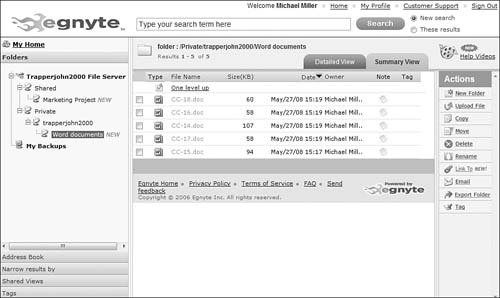Understanding Cloud Storage
The first form of web-based data storage we’ll examine is called cloud storage. This is a form of networked data storage where data files are stored on multiple virtual servers.
What Is Cloud Storage?
The servers used for
cloud storage are typically hosted by third-party companies who operate
large data centers. When you subscribe to a cloud storage service, you
lease storage capacity from the cloud storage service. You then have
access to the contracted amount of storage space, which you access via
the Internet.
What you see looks like a
single server or hard disk, but it’s really just a virtual server. In
reality, your data may be stored across multiple servers, sometimes
spanning multiple locations (or even continents!) that then appear to be
a single server in your storage dashboard.
Know that true cloud
storage is massive. We’re not talking mere gigabytes and terabytes, as
you might find on a desktop PC or web server. Instead, a cloud storage
service might offer multiple petabytes of storage.
Note
One terabyte equals 1,000 gigabytes, and 1 petabyte equals 1,000 terabytes.
The best-known
cloud storage service today is probably Amazon.com’s Simple Storage
Service (S3). Cloud storage is also offers by many other companies, with
services either planned or rumored from IBM, Google, and EMC.
Note
I like the way Geoff
Tudor, the co-founder of cloud storage provider Nirvanix, describes
cloud storage. He compares cloud storage to electrical service: When you
turn on a light switch, you don’t know exactly from where each
individual electron originates. The same applies to stored data in the
cloud—although you might not know where that data is physically stored,
all you care about is that you have access to that data.
Why Use Cloud Storage?
Why is cloud storage such a big deal—especially to large companies? There are three primary benefits to cloud storage:
Scalability.
When you rent cloud storage space, you can opt to use as much or as
little space as you need. It’s easy to “flip and switch” and increase
your storage space if you suddenly have larger storage needs. You don’t
have to buy the additional computers required to house the extra data,
but rather can use more of the space available in the cloud (and feel
free to use as much space as you need).
Reliability. If
you’ve ever had your company’s server go down, you know how important
it is to have access to backup data. Well, cloud storage can be used as
giant online backup drive. Even if you rely on cloud services for your
primary data storage, you still have the peace of mind that comes from
knowing your data is duplicated on multiple servers.
Lower costs.
How much do you pay per terabyte of storage? Even with hard disk prices
coming down, it’s still cheaper to use the virtual servers in the
cloud. Cloud storage services can offer lower storage rates because they
more efficiently use the server space they have; space gets reassigned
to users almost instantly, on an as-needed basis.
It’s a lot cheaper to use excess space in the cloud than it is to purchase a new server or hard disk drive.
Risks of Storing Data in the Clouds
Of course, some risk is associated with using cloud storage services. Let’s look at the most talked-about issues:
Reliability.
Remember when I said cloud storage is more reliable than traditional
physical storage? That might not always be the case. What do you do when
your cloud service provider has technical problems and either goes
offline (which means you can’t access your data) or actually loses
stored data? It’s happened before. Amazon had a well-publicized outage
of its storage service in February 2008. If a cloud storage service
doesn’t have adequate infrastructure or doesn’t maintain multiple
backups, your data could be at risk.
Security.
While all cloud storage providers tout how secure their systems are,
there still exists the possibility that high-tech thieves could break
into the system and view or steal your sensitive data. It’s almost
always less safe to store your data elsewhere than where you have
physical control over it.
User error.
Not all reliability security issues originate with the cloud storage
provider. Given that you employ fallible human beings to manage your
systems, it’s not inconceivable that someone could inadvertently let a
password slip, or enter an incorrect web address. All it takes is one
simple mistake to expose your data to unauthorized users or permanently
delete data you don’t want to delete.
Access problems. Because
you’re accessing your data over an Internet connection, you’re in big
trouble if that connection goes down—either on your end or with your
cloud storage provider. And the connection doesn’t have to go completely
down to cause problems; latency in accessing data is an issue with any
Internet connection, even the fastest ones. Slow connections, of course,
present problems of their own, in terms of time it takes to upload and
download files.
With all these caveats in
place, it makes sense to back up data in at least two places, and not
rely exclusively on the cloud for all your storage needs. Whatever you
store in the cloud should also be stored somewhere more accessible, for
safety’s sake.
Evaluating Online File-Storage and -Sharing Services
Where online can you
store your valuable data? Let’s look at some of the more popular cloud
storage services—many of which also offer file-sharing capabilities.
Amazon S3
The Amazon Simple
Storage Service (S3) provides unlimited online storage. You access your
stored data via a simple web interface. S3 launched in March 2006,
making it one of the most established online storage services in today’s
market.
Amazon charges fees for
the amount of data stored and for the bandwidth used in uploading and
downloading that data. In the United States, you pay $0.15 per gigabyte
of storage used, plus a data transfer fee that ranges between $0.10 and
$0.17 per gigabyte transferred.
One of the selling
points for S3 is that it uses the same scalable storage infrastructure
that Amazon.com uses to run its own global e-commerce website. You
access Amazon S3 by going to aws.amazon.com and clicking the Amazon
Simple Storage Service link.
Egnyte
Egnyte (www.egnyte.com)
provides online file storage, backup, and sharing. You can easily
designate authorized users with whom to share specific files and
folders, complete with automatic file versioning.
Access to the Egnyte service is via the simple web interface you see in Figure 1.
You set up a virtual online file server that you configure according to
your specific needs. You can then designate shared folders and
subfolders with different permissions for power users and standard
users. Uploading files is as easy as clicking a few buttons. Anything
you upload to your shared folders can then be shared with other users
you authorize.

ElephantDrive
ElephantDrive (www.elephantdrive.com)
is a user-friendly online file-storage service. They offer three
different versions of different-sized users: Home Edition, Pro Edition,
and Pro Plus Edition. Each edition has different storage and transfer
limits. The Home Edition is priced at an affordable $9.95/month.
Microsoft Office Live Workspace
We first discussed Microsoft Office Live Workspace (workspace.office.live.com) back in “Collaborating on Spreadsheets.” Think of Live Workspace as a
specialized cloud storage service; you can use it to store Microsoft
Office documents and Office documents only. In addition, you’re limited
to the number of documents you can store, typically around 1,000 per
user.
The
nice thing about Office Live Workspace is that it’s free—although you
do need to own the Microsoft Office suite to create your Office
documents, of course.
This makes it a great way
to store your main or backup copies of your Word, Excel, and PowerPoint
documents. You can also access your documents from any location, whether
you’re in the office, at home, or on the road. What you can’t do,
however, is store non-Office documents, which makes it a rather limited
data-storage service.
Note
If you want to share
live documents and the contents of your computer desktop with a small
group of coworkers or friends, check out Microsoft SharedView (connect.microsoft.com/site/sitehome.aspx?SiteID=94).
Not a cloud application per se, SharedView is a remote desktop and
conferencing system that lets you show and share documents (and chat)
with up to 15 people at once. Each participant installs the SharedView
software on his or her PC; when you start a session, each client
communicates with the others using IM-like technology. (In fact,
SharedView works with Windows Live Messenger.) What you don’t get is
true collaboration; SharedView is more suited for computer-based
dog-and-pony shows. Still, it’s yet another way to share your documents
and other work with colleagues over the web.
Mosso
Mosso (www.mosso.com)
is a business-ready cloud hosting platform. Both storage and bandwidth
scale automatically as needed; you pay on a per-gigabyte basis for what
you actually use.
You can use Mosso
to host anything from individual files to complete websites. In fact,
Mosso let you serve as your own website hosting service, complete with
domain registration and client billing services.
myDataBus
The myDataBus service (www.mydatabus.com)
is a combination cloud storage and file-sharing service. You can use
myDataBus to store your individual files or to share photos, videos, and
music with your friends and family. The service also offers group
collaboration tools and integration with Facebook, MySpace, LiveJournal,
and other similar sites.
Nirvanix
If your storage needs are larger, consider Nirvanix (www.nirvanix.com).
Nirvanix is a cloud storage platform optimized for large files and
large enterprise-level customers. The Nirvanix Storage Delivery Network intelligently
stores, delivers, and processes storage requests in the best network
location. Storage is offered on an on-demand, completely scalable basis.
steekR
As you can see in Figure 2, steekR (www.steekr.com)
is designed especially for consumers who want to share their documents
and media files online. After you’ve uploaded a file, you can share it
with anyone in your contact list. You can also opt to make specific
files editable by other, or assign them read-only restrictions.

The basic steekR service, with 1GB of storage, is free. Paid plans, with up to 100GB of storage, are also available.
Windows Live SkyDrive
Now we come to Microsoft’s second cloud storage service. Windows Live SkyDrive (skydrive.live.com)
differs from Office Live Online in that you can use it to store any
type of file, not just Office files. You get 5GB of free storage, and
can easily share your uploaded files with others you authorize via
shared or public folders. Personal folders are used for files you want
to keep private.
As you can see in Figure 3,
uploading and managing your files is accomplished via an easy-to-use
graphical dashboard. Just click a folder to view its contents or open an
individual file. It’s quick and easy, ideal for home or small business
users—including those who want to collaborate over the web with other
users.
